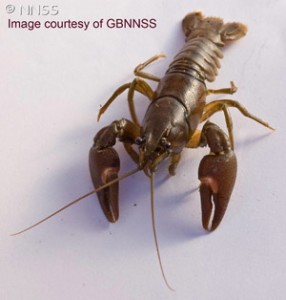Signal Crayfish

Plants and animals from different parts of the world are being ‘mixed’ up as worldwide travel by train, boat and plane increases year by year. The woodlands' blog has reported on a number of plants and animals that are regarded as ‘aliens’ or invasive species, for example, the 'killer shrimp'. Sometimes the ‘concern’ proves to be unfounded, but the arrival of various pathogens can be problematical for 'native species'.
At some point back in the 1970’s, the North American signal crayfish arrived in the U.K. Since that time it has spread through various river systems, particularly in South and South East England, at the rate of 2 km per year (approx.). Its spread may have been assisted by damp fishing gear. It would seem that the signal crayfish is out-competing the native white clawed crayfish (that is, native to Europe, including England, Wales and Ireland – but not Scotland).
The signal crayfish can eat more and is a less fastidious feeder than the (native) white clawed crayfish, plus the signal crayfish carry ‘crayfish plague’ – a fungal parasite that particularly affects the white clawed form. The white crayfish is also affected by &#
039;porcelain disease', in which the parasite affects the legs and movement of the animal. Dr Alison Dunn of the University of Leeds has been working on how host-parasite interactions can affect the outcome of ‘invasions’.
The signal crayfish also competes with the white clawed crayfish for shelter – so these two species occupy the same niche on a number of levels (Gause's mutual exclusion principle). The signal crayfish is also suspected of damaging river banks through its burrowing activities. In Scotland, the signal crayfish is being viewed as a possible threat to salmon - partly through competing for shelter with young fish but also it may be that the eggs are eaten by the crayfish. The white clawed crayfish is now on the IUCN Red List.
See http://www.ceh.ac.uk/sci_programmes/Water/documents/11-05_Gladman-Crayfish-web-pdf.pdf
Further information on various invasive / non native species can be found at
Comments are closed for this post.

Haha, trust Monbiot to eat them!
Tom
5 March, 2012